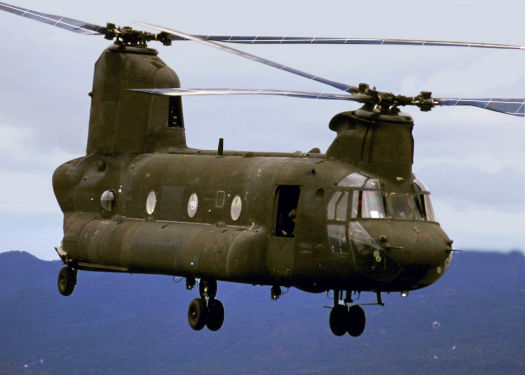
The U.S. Army is pleased to announce that they will soon begin the process of converting their fleet of Boeing CH-47 Chinook helicopters to solar power.
Now identified as Sunfish, as the solar Chinooks will retain their distinctive rotor noise but no longer emit the turbine engine noise associated with these aircraft. The conversion process, where solar absorbing cells are embedded into the surface of the rotor blades and the fuselage, eliminates the need for engines, fuel systems and onboard fuel tanks. State-of-the-art, high-capacity batteries and aviation-grade electric motors will provide power for the tandem-rotor aircraft.
“Several years ago, one of our soldiers recognized that the massive surface area of our six rotor blades would be sufficient for this process,” said Maj. Gen. T.J. Kong, head of the U.S. Army’s Aviation Research Office. “Recent technology in solar nano-technology made it possible for us to actually embed millions of incredibly small, solar absorbing cells in each blade. The cells in the blades alone provide the 1.21 gigawatts of energy necessary to power the aircraft. However, we added extra panels to the fuselage for redundancy and to assist in charging the batteries for nighttime operations.”
Each of the six rotor blades on the Chinook measure approximately three-feet wide and are approximately 25-feet long. When turning, the rotor blades combine to cover an area of approximately 5,000 square feet.
Flight testing during military operations in Afghanistan and the Middle East have proved especially successful. “In addition to supplying power, the solar power system also has the advantage of eliminating the engine heat signature,” continued Kong. “This will make these aircraft more difficult to strike with heat-seeking missiles.”
“Battery technology has also advanced significantly, providing us with the light-weight, high-capacity storage we require,” added Kong. “The solar cells provide the energy we need, but we wouldn’t have been functional without the talc-based batteries needed to store the power. The aircraft battery cells can also be plugged into standard home electrical sockets during extended periods of cloudy weather.
“We have already been approached by several other Chinook operators who are interested in converting their fleet,” said Kong. “We’re not alone in our quest to be a greener operator.”









